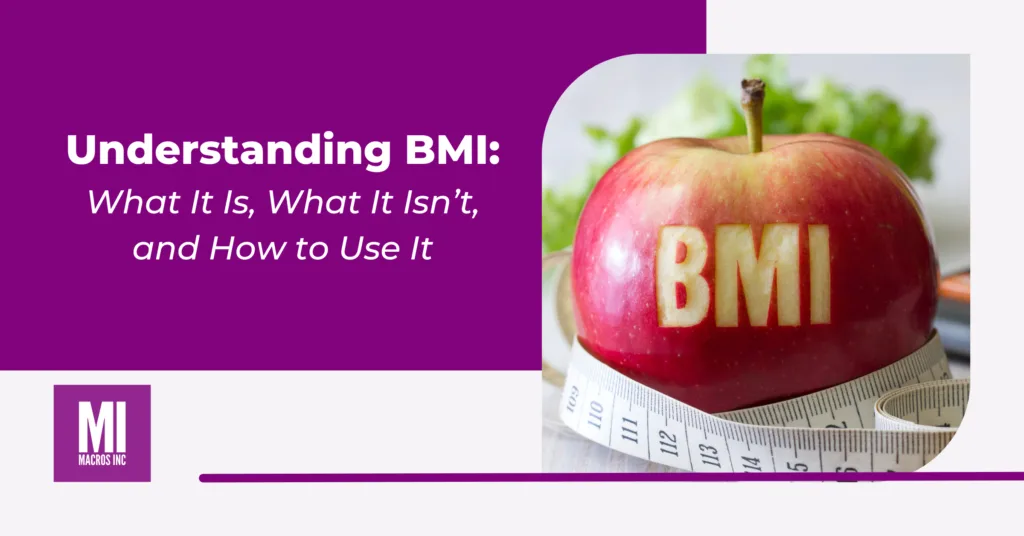Lately, there’s been a lot of discussion about BMI (Body Mass Index) on social media and in health articles. Some people argue it’s outdated, others say it’s flawed, and a few insist it should be thrown out altogether.
But here’s the thing: it is here to stay. Whether we like it or not, it plays a major role in healthcare, from insurance calculations to medical assessments. That’s why we need to understand it – what it is, what it isn’t, and how to use it effectively.
So, grab a cup of coffee, because this is going to take a few minutes – but I promise it will be worth it.
Jump to a Topic
Understanding BMI: What It Is, What It Isn’t, and How to Use It
What Is It?
Simply put, Body Mass Index is a single number calculated based on your height and weight. That’s it. It’s unitless and is determined by dividing your weight (in kilograms) by the square of your height (in meters). The resulting number is then categorized into different classifications:
- Underweight: BMI below 18.5
- Normal weight: BMI 18.5 – 24.9
- Overweight: BMI 25 – 29.9
- Obese: BMI 30 and above
There are more detailed breakdowns within the obese category, but these are the broad classifications most commonly used.
The Criticisms of BMI
BMI has faced several criticisms over the years. Here are a few key concerns:
- It doesn’t distinguish between muscle and fat
Someone with a lot of muscle mass (like a bodybuilder) may be classified as overweight or even obese, even if their body fat percentage is low.
- The normative data used to create BMI categories isn’t representative of all populations.
BMI was developed centuries ago based on data from a homogenous population, meaning it may not accurately apply to everyone.
- It tends to be less accurate for people who are much taller or much shorter than average.
Shorter individuals often have BMI overestimate their body fat, while taller individuals may have it underestimated.
- It may underestimate health risks in individuals with a “normal” BMI but higher body fat percentage.
In fact, BMI is often more forgiving of individuals who fall within the “normal” weight range but have a higher percentage of body fat and lower muscle mass, a condition sometimes referred to as “normal weight obesity” or being “skinny fat.” These individuals may still carry elevated health risks despite what appears healthy on paper.
While these criticisms are valid, it’s important to understand BMI’s original purpose. It was designed as a tool for analyzing population-level health trends, not as a perfect diagnostic measure for individual health.
How We Should Actually Think About It
BMI is not the ultimate measure of health, but it can be useful, especially when used alongside other health metrics. The key is knowing when and how to use it.
Where It Excels: Risk Prediction
Despite its limitations, BMI is one of the most effective risk prediction tools in modern medicine. When analyzed alongside other factors, it helps identify the likelihood of developing chronic diseases.
Here are five major health risks associated with a high Body Mass Index:
- Cardiovascular Disease
- People with the highest BMI classifications have up to a 3x higher risk of a cardiovascular event compared to those with a normal reading (Khan et al., 2018). Even being in the “overweight” category increases risk by about 20%.
2. Diabetes
- BMI is a strong predictor of diabetes risk. Some studies show that individuals in the “overweight” category have a 6x higher risk of developing diabetes compared to those in the “normal” category (Sanada et al., 2012).
3. Cancer
- Higher BMI is linked to an increased risk of certain cancers, including liver and colon cancer (Bhaskaran et al., 2014).
4. Hypertension (High Blood Pressure)
- Research indicates that for every unit increase in BMI, blood pressure increases by 1-2 mmHg (Linderman et al., 2018).
5. Stroke
- Individuals with a calculation of 30 or higher have a 2x increased risk of stroke (Kurth et al., 2002).
A Piece of the Health Puzzle, Not the Whole Picture
It’s crucial to recognize that BMI is a risk factor, not the risk factor. It should be used in conjunction with other health markers such as:
- Age
- Sex
- Blood pressure
- Fasting glucose levels
- Cholesterol and triglyceride levels
- Smoking and alcohol intake
BMI is not a standalone diagnostic tool, but it consistently shows up as an independent risk factor for numerous health conditions.
The Take-Home Message
- BMI is a useful tool, but it has limitations. It’s not perfect for assessing individual body composition but is extremely valuable in identifying health risks.
- Don’t ignore it just because it’s imperfect. It plays an important role in understanding population health and predicting chronic disease risk.
Use BMI as part of your total health profile. It should be considered alongside other health indicators to get a complete picture of your well-being.
Try our nutrition coaching, for free!
Be the next success story. Over 30,000 have trusted Macros Inc to transform their health.
Simply fill out the form below to start your 14-day risk-free journey. Let's achieve your goals together!

